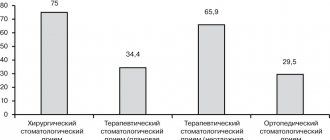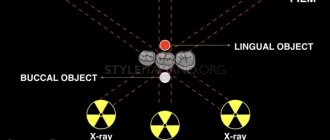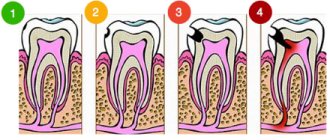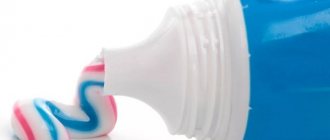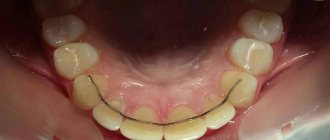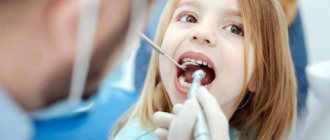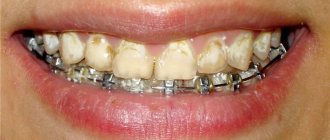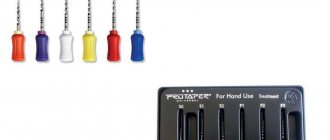Treatment of pathological tooth wear presents certain difficulties associated with disorders of various elements of the masticatory apparatus. Increased abrasion causes disorders in the temporomandibular joint, bone tissue and masticatory muscles. Such disorders further aggravate the pathological process, making it difficult to determine cause-and-effect relationships and create effective prevention and treatment plans to stop increased abrasion.
What is a comprehensive treatment plan?
A comprehensive dental treatment plan is a plan to correct a patient's oral health situation. It is compiled based on consultations with dentists of various specializations and the results of diagnostic studies.
A comprehensive plan necessarily includes the following blocks:
- Description of the patient’s situation and any abnormalities identified during the examination.
- Possible solutions to problems.
- Stages and timing of treatment.
- Methods, materials and costs.
The procedure for examining a patient and filling out a medical history during orthopedic treatment
- home
- For patients
- Articles
- The procedure for examining a patient and filling out a medical history during orthopedic treatment
- 1. Last name First name Patronymic (of the patient).
- 10. Type of bite.
- 2. Current complaints.
- 11. Language.
- 3. History of the disease.
- 12. Additional examination methods.
- 4. General condition.
- 13. Diagnosis.
- 5. External inspection.
- 14. Plan for preparing the oral cavity for prosthetics.
- 6. Research of TMJ.
- 15. Orthopedic treatment plan.
- 7. Objective data.
- 16. Diary.
- 8. Inspection of the system.
- 17. Dispensary observation.
- 9. Examination of teeth and dentition.
- 18. Epicrisis.
Last name First name Patronymic (of the patient).
Current complaints: impaired chewing, aesthetics, tooth mobility, increased sensitivity of teeth, pain in the TMJ, pain under the base of a removable denture, poor fixation, pain in the tooth under the crown, bleeding gums, bad breath, suppuration, swelling of soft tissues , taste disturbances, etc. Complaints about parafunctions of the masticatory muscles (is there a habit of biting your lips or clenching your teeth while watching a movie, reading books or working, is there a habit of grinding your teeth, complaints from the masticatory muscles (pain, fatigue)).
History of the disease: when did certain complaints appear, what is it associated with (caries, periodontitis, periodontal disease, trauma, surgery, etc.), whether treatment or prosthetics were previously carried out (how long ago?).
General condition: presence or absence of bad habits (smoking, drinking alcohol), concomitant diseases (chronic diseases; hepatitis, tuberculosis, syphilis, HIV), allergy history, whether anesthesia was previously performed during treatment, tooth extraction, its effectiveness.
External examination: skin color, presence of defects, symmetry and type of face (conical, obverse-conical, square, round), height of the lower third of the face, protrusion of the chin, pattern of lip closure, severity of nasolabial and chin folds.
Research of the TMJ: opening of the mouth (intermittent, free, the nature of the movement of the lower jaw is smooth or jerky, displacement of the lower jaw to the side), the presence of crunching, clicking, noise in the TMJ when moving the lower jaw.
The state of the tone of the masticatory muscles and their soreness on palpation, the state of the submandibular lymph nodes, their soreness and size on palpation.
Objective data
| 8 | 7 | 6 | 5 | 4 | 3 | 2 | 1 | 1 | 2 | 3 | 4 | 5 | 6 | 7 | 8 |
Inspection of the mucous membranes: color and moisture content of the mucous membranes, color and shape of the gingival papillae.
Examination of teeth and dentition:
- condition of intact teeth (size, anomalies of position, shape, color of hard tissues, mobility, exposure of necks or abrasion of teeth (degree), sensitivity (type: hot, cold, sour, sweet, etc.), size of periodontal pockets);
- condition of teeth with defects of hard tissues (size and topography of the defect, condition of fillings is satisfactory or not, IROPD, mobility, exposure of necks or abrasion of teeth (degree), sensitivity (percussion, probing, temperature reaction), size of periodontal pockets);
- condition of inlays, veneers, pin structures (size, topography, condition, correspondence to the bite, mobility of the abutment tooth or prosthesis, exposure of the necks (degree), sensitivity), crowns, bridges (size, topography, condition, correspondence to the bite, mobility of the abutment teeth, exposure of the necks of the supporting teeth, sensitivity, abrasion of the chewing or other surface of the dentures), the size of the periodontal pockets of the supporting teeth;
- condition of removable dentures (type, integrity of the base and prosthesis fixation systems, service life, fixation of the denture in the oral cavity, balance, compliance with boundaries).
Type of bite: fixed, not fixed; orthognathic, direct, biprognathic, prognathic, progenic, cross, deep, open.
Condition of the dentition: shape, size and topography (classification) of defects, secondary deformations and movements of teeth.
Condition of toothless jaws: classification of the upper jaw (Doinikov, Kurlyansky, Oksman, Schroeder), lower jaw (Doinikov, Keller, Kurlyansky, Oksman); degree of mucosal compliance according to Supple; attachment of the frenulum of the upper and lower lips, buccal-gingival cords.
Tongue: size (normal, microglossia, macroglossia), shape (round, oval, V-shaped), attachment of the frenulum of the tongue.
Additional examination methods: description of x-ray examination (intraoral x-ray, panoramic x-ray, orthopantomography, targeted x-ray of teeth), description of diagnostic models, study of loss of chewing efficiency according to I.M. Oksman
| teeth | 1 | 2 | 3 | 4 | 5 | 6 | 7 | 8 | Total |
| V/H | 1 | 1 | 2 | 3 | 3 | 6 | 5 | 4 | 25% |
| LF | 2 | 1 | 2 | 3 | 3 | 6 | 5 | 3 | 25% |
Diagnosis is a logical conclusion, a synthesis of the obtained subjective and objective research data. The diagnosis in orthopedic dentistry should reflect the size and topography of defects in the hard tissues of teeth, dentition, the condition of the oral mucosa, as well as concomitant diseases of the dental system and complications.
For example:
- a defect in the hard tissues of the tooth (necessarily which one?), carious, non-carious or traumatic origin (non-carious diseases include: enamel hypoplasia, wedge-shaped defects, fluorosis, acid necrosis and pathological abrasion; trauma - acute and chronic), the degree of destruction of the coronal part of the tooth must be indicated .
- partial edentia (which jaw?) according to Kennedy: bilateral end (I class), unilateral end (P class), included in the area of the lateral teeth (W class), isolated included in the frontal region (1U class). Complications: traumatic occlusion, decreasing bite, secondary deformation (Godon-Popov phenomenon).
- complete adentia: degree of atrophy according to I.M. Oksman, pliability of the mucous membrane according to Supple.
Plan for preparing the oral cavity for prosthetics: sanitation of the oral cavity (removal of dental plaque, dental treatment, removal of teeth or roots); special preparation (depulpation of teeth, elimination of occlusal disorders, orthodontic preparation, alveolotomy, excision of scars, strands of the mucous membrane, deepening of the vestibule or floor of the oral cavity).
Orthopedic treatment plan:
- Inlay, veneer from what material and for what tooth;
- Pin structure (single-root, dismountable, how it is made, temporary, permanent) on the abutment tooth;
- Single crown (from what material) on the abutment tooth;
- The bridge prosthesis is made of what material, supported by what teeth;
- Partially removable laminar denture on the upper part, lower part, with which teeth (plastic, ceramic, porcelain), clasps on which teeth;
- Clasp prosthesis (splinting clasp prosthesis) indicating the fixation system (cast clasps, type of attachments, telescopic crowns) and on which teeth;
- Other types of structures are possible, indicating the type of materials, manufacturing method and supporting teeth.
Diary: displays the date of patient admission, the amount of work performed and must be certified by the signature of the immediate supervisor.
Dispensary observation: if necessary, the date of examination (year, month) of the subsequent visit for the following diseases is noted: pathological abrasion, periodontal tissue diseases, complete edentia, etc.
Epicrisis: describes the scope of orthopedic treatment (aesthetics, anatomical shape of teeth, integrity of dentition, height of the lower third of the face, tooth mobility), indicates the extent to which chewing efficiency has been restored (according to I.M. Oksman), and provides recommendations for oral care and the use of prostheses.
ILLUSTRATIVE EXAMPLE
“Maintaining an outpatient card for a dental patient”
Last name I.O.: Ivanov V.P.
Year of birth: 1991.
Current complaints: disturbances in chewing and aesthetics.
History of the disease: a day ago, the crown of the central tooth of the upper jaw broke off while eating. The tooth was treated three years ago due to caries complications.
General condition: bad habits – smokes; concomitant diseases – no; hepatitis, tuberculosis, syphilis, HIV – denies; allergy history - not burdened, anesthesia was previously carried out, effective, without pathologies.
External examination: skin color – clear; face – symmetrical; face type – conical; the height of the lower third of the face is not changed; the chin does not protrude; lips close without tension; nasolabial and chin folds are moderately pronounced; mouth opening – free, painless; movements of the lower jaw are smooth, there are no displacements during movement.
Examination of the TMJ: the presence of crunching, clicking, noise in the TMJ during movement of the lower jaw is not recorded, the masticatory muscles are painless on palpation, the submandibular lymph nodes are painless on palpation and are not enlarged.
Objective data:
| P | R | P | P | ||||||||||||
| 8 | 7 | 6 | 5 | 4 | 3 | 2 | 1 | 1 | 2 | 3 | 4 | 5 | 6 | 7 | 8 |
| P | P | P |
Examination of the oral mucosa: the mucous membrane is pale pink, moderate humidity, gingival papillae are normal.
Examination of teeth and dentition:
- intact teeth without pathology, not mobile, percussion and probing are painless, temperature reaction is negative, periodontal pockets are 0.1 mm.
- The fillings are in satisfactory condition, correspond to the bite, the marginal fit is tight.
The teeth are not mobile, percussion probing is painless, the temperature reaction is negative. IROPZ 16; 25; 26; 36; 44; 45 – 0.5.
Type of bite: fixed, straight.
Condition of the dentition: the shape of the dentition is ellipsoidal in the upper jaw, parabolic in the lower jaw. There are no secondary deformations.
Tongue: normal size, oval shape, normal frenulum.
Additional examination methods: from 07/05/2010. On an intraoral radiograph, there are 21 teeth in the periapical tissues without pathological changes, the canal is sealed to the physiological aperx, along its entire length.
or according to I.M. Oksman
| teeth | 1 | 2 | 3 | 4 | 5 | 6 | 7 | 8 | Total |
| V/H | 1 | 1 | 2 | 3 | 3 | 6 | 5 | 4 | 25% |
| LF | 2 | 1 | 2 | 3 | 3 | 6 | 5 | 3 | 25% |
Loss of chewing efficiency – 3% according to I.M. Oksman.
Diagnosis – defect of hard dental tissues as a result of caries, destruction of crown 21 on 1/2 of the surface, IROPD 16; 25; 26; 36; 44; 45 – 0.5; loss of chewing efficiency 3% according to I.M. Oksman.
Plan for preparing the oral cavity for prosthetics: not carried out.
Orthopedic treatment plan: stump pin design for 21 teeth; single metal-ceramic crown for 21 teeth.
Diary:
| date | Volume of work performed | Manager's signature |
| 5.07.2010 | Inspection, documentation. Preparation of the root of the 21st tooth for a core post structure, modeling the post structure in the oral cavity with Lavax wax, applying a temporary filling - dentin paste. | |
| 6.07.2010 | Checking and fitting the metal stump pin structure to the root of the 21st tooth. Honey. treatment of the root and canal of the 21st tooth with 3% hydrogen peroxide and liquid for degreasing the canals, air; metal stump pin structure - 95% alcohol, air. Fixation of a metal stump pin structure into the root of the 21st tooth on a Fuji. | |
| 7.07.2010 | Under application anesthesia with Ludoxor spray, insertion of a retraction thread into the periodontal sulcus of the 21st tooth, preparation of the 21st tooth for a metal-ceramic crown. Taking a double impression from the upper jaw “Spidex”, from the lower jaw – an alginate impression “Hydrogum soft”. | |
| 8.07.2010 | Determination and fixation of central occlusion. | |
| 10.07.2010 | Checking and fitting the cast frame of a metal-ceramic crown for 21 teeth. Determination of the color of ceramic cladding: Ivoclar – 4 A. | |
| 12.07.2010 | Checking and fitting a metal-ceramic crown for 21 teeth. Honey. treatment of the stump of 21 teeth with 3% hydrogen peroxide and air; metal-ceramic crown - 95% alcohol, air. Fixation of a metal-ceramic crown for 21 teeth on “Fuji”. Advice and recommendations on oral care and denture care are given. |
Dispensary observation: the patient does not need a preventive examination of the oral cavity once every six months.
Epicrisis: as a result of orthopedic treatment of a defect in the hard tissues of the 21st tooth, the anatomical shape, aesthetics, integrity of the dentition of the upper jaw, and chewing efficiency were restored in full (100%).
Patient V.P. Ivanov, born in 1991, was given the necessary recommendations for caring for the oral cavity and the metal-ceramic crown on the 21st tooth.
Why do you need a comprehensive treatment plan?
Often, dental problems are associated with reasons that are invisible at first glance, the elimination of which will help avoid relapses. Sometimes it is impossible to correct the situation only with the help of therapeutic treatment; the help of an orthopedist and periodontist is necessary. Orthodontic treatment is not always possible without surgery. There are many such examples.
Having a comprehensive plan allows you to approach the issue of treatment systematically and completely. The patient’s situation is analyzed from all sides, resulting in the optimal and most effective solution.
Orthopedic dentistry
Orthopedics is a large branch of dentistry that deals with the elimination of violations of the integrity and defects of the maxillofacial area. The basis of orthopedic dental treatment is prosthetics.
There are two main treatment methods :
- Dental restoration. Suitable for situations where the tooth is not completely lost. The area of the missing tooth is filled with special orthopedic structures (stump inlays, pins, etc.). Thus, the damaged dentition is restored to its original appearance.
- Prosthetics. This option is used for complete tooth loss. An orthopedic dentist selects an individual denture. There are several types of structures, differing both in the materials from which they are made and in the installation methods.
Which specialists are necessary to consult to draw up a comprehensive treatment plan?
Since the comprehensive plan is aimed at total treatment, dentists of different specialties are involved in its preparation: therapist, orthodontist, implant surgeon-periodontist, orthopedist, hygienist and radiologist.
It is almost impossible to be a highly professional multidisciplinary specialist. Each dentist has his own professional orientation in which he is strongest. Therefore, several highly specialized specialists with deep knowledge of their field are working on oral cavity rehabilitation.
Let's look at, for example, the destruction of a chewing tooth in the lower jaw
The patient came with complaints about the crown of tooth 46 chipping while eating; the patient does not experience any pain, but he is bothered by the sharp edge of the tooth, which scratches his tongue. The tooth chipped the day before.
The patient denies the presence of chronic diseases, HIV, hepatitis and allergic reactions.
An external examination, examination of the condition of the temporomandibular joint and the condition of the oral mucosa revealed no pathologies. In the oral cavity, the condition of the teeth is satisfactory; no pathologies other than a chipped tooth 46 were identified. The plaque is scanty - the patient had professional oral hygiene a month ago.
The patient's bite is correct and orthognathic.
When examining the chipped tooth 46, we note that the tooth is depulped, while the seal is preserved - an insulating gasket is in place - it protects the filling material of the tooth root canals from infection by oral bacteria. The chip occurred to approximately half the height of the tooth crown on the lingual and distal (back) sides. In this case, the size of the defect in the coronal part of the tooth is more than half the size of the crown.
Next, we move on to additional research methods - we will do an OPTG to identify possible defects on other teeth and assess the condition of neighboring teeth and teeth opposite on the upper jaw and a CT scan in the area of tooth 46 to determine the quality of canal filling and the presence of inflammation in the root area 46.
In the photographs we see that the canals are sealed tightly, up to the apical foramen (that is, to the end) and there are no clearings to suspect the presence of inflammation. The adjacent teeth are vital and do not require treatment.
First appointment
The number of doctors involved depends on each specific situation. But first, you need to make an appointment with a general practitioner, he will continue to act as your curator or coordinating doctor.
At the initial consultation, an examination and conversation with the patient is carried out, an anamnesis is collected, all his concerns and wishes for the outcome of treatment are identified, and diagnostic tests are prescribed. Based on their results, the first consultation of doctors of all necessary specialties is held and subsequent meetings are scheduled.
Diagnostics – a waste of money or a necessity?
No matter how excellent a professional a dentist is, he will receive only 30% of the information based on an examination and conversation with the patient. To obtain an overall picture and draw up the most accurate treatment plan, diagnostic studies are mandatory.
At the Confidential clinic we use the following diagnostic methods:
- 3D digital x-ray diagnostics;
- determination of the hygienic index;
- hardware laser diagnostics of caries;
- photo protocol;
- bite diagnostics;
- periodontal diagnostics;
- orthopedic diagnostics.
The choice of necessary diagnostic methods in each specific case is discussed with the supervising physician. Additionally, you may be recommended to undergo examination by specialists in other fields of medicine, including laboratory tests.
Partially removable dentures
Partial removable dentures are made to fit a portion of the toothless jaw and are secured with discreet clasp hooks. After each meal, the denture should be removed and rinsed with running water.
Some people find it difficult to get used to removable dentures, but if you follow the tips that can be found at this link, the adjustment process will be much easier. The main advantage of removable dentures is that in order to remove or put on the denture you do not need to go to the dentist, the process of cleaning and caring for the structure becomes easier.
At the Consilium Dent dental clinic, all work on the selection, manufacture and installation of prostheses is performed by experienced orthopedic dentists who are capable of solving the most complex clinical problems.
When you contact the clinic, our doctors will make temporary prostheses on the same day, which can be used until the end of treatment. This will provide our patients with maximum comfort and help hide aesthetic imperfections.
Predicting the result
In our clinic we offer you two stages of visualization of the results of a comprehensive treatment plan:
- Computer smile design is a virtual model of your smile after treatment, which we show to you using software on a computer.
- A wax-up is a tangible model of your teeth, a planned result achieved using the methods described in a comprehensive plan and which you can “try on” in order to evaluate whether it meets your expectations.
Acceptance of the proposed treatment plan, adjustments to it, or refusal of treatment is accompanied by a conversation between the patient and the doctor.
The doctor’s task is to tell about all possible treatment options and the results achieved with their help, to advise on the likely risks of refusing a number of diagnostic tests, changing materials, excluding certain stages of treatment, and the consequences of refusing it.
The decision is always up to the patient, but the doctor is obliged to provide the patient with comprehensive information.
Why do comprehensive treatment plans vary from clinic to clinic?
One clinic will have one treatment plan, another clinic will have another. This is due to a number of factors. A comprehensive treatment plan depends on:
- availability of certain specialists in the clinic;
- experience and knowledge of clinic doctors;
- technical equipment of the clinic;
- the level of interaction between doctors, the high-quality transfer of information by them to each other about the progress of the patient’s treatment.
The Confidence clinic is equipped with modern equipment, advanced diagnostic and treatment technologies. The clinic welcomes specialists who are speakers for a number of Russian companies and conduct scientific activities. These are high-class professionals who work according to international protocols and master techniques at the level of world specialists.
Dentures
Dentures are structures designed for full or partial restoration of the dentition. There are three types of prostheses:
- Removable;
- Fixed;
- Partially removable.
For each individual case, the orthopedic dentist selects an individual type of design. Its choice depends on many factors: the health of the patient’s body as a whole, structural features of the maxillofacial area, the presence of other oral diseases, treatment methods used in this clinic.
Innovative materials and the latest technologies in the field of orthopedic treatment allow us to achieve excellent results. The service life of modern prostheses reaches more than 10 years. They are distinguished by excellent aesthetic qualities, comfort and ease of wearing.
Artificial teeth used on modern structures are almost impossible to distinguish from natural teeth.
The development of orthopedic dentistry does not stand still; new developments and materials are constantly appearing. However, classical prosthetic methods are not excluded. Methods are emerging that combine various areas of dentistry.
For example, modern dentures are often fixed on mini-implants. Thus, the treatment uses the best practices of both implantology and orthopedics.
Prices
| NAME OF SERVICE | SERVICE COST |
| Consultation with the chief physician, dentist-therapist of the highest category | 1,500 rub. |
| Diagnosis of caries using the Diagnocam device | 700 rub. |
| Assessment of periodontal condition (diagnosis) | 3,300 rub. |
| 3D computed tomography | 3,200 rub. |
| Conclusion of a radiologist based on the results of an x-ray examination | 500 rub. |
| Diagnosis of bite | 3,500 rub. |
| Diagnostics by an orthopedist | 3,500 rub. |
Rate this material:
5
